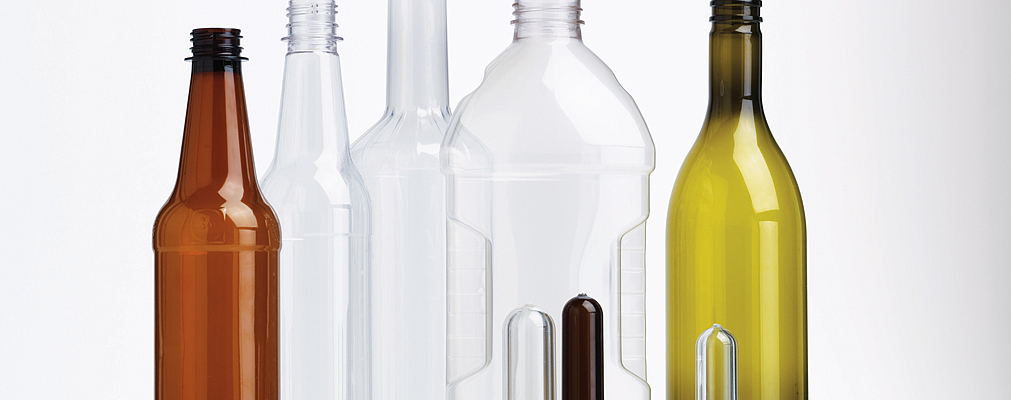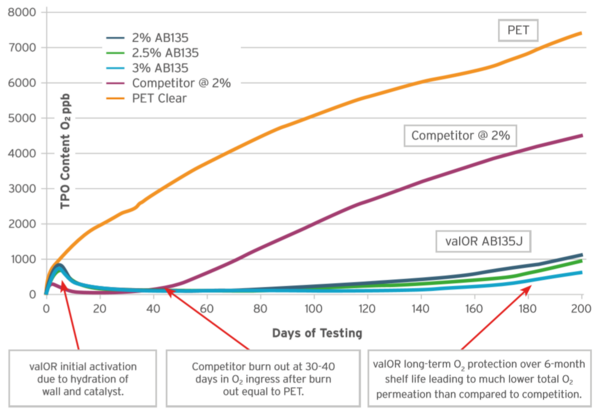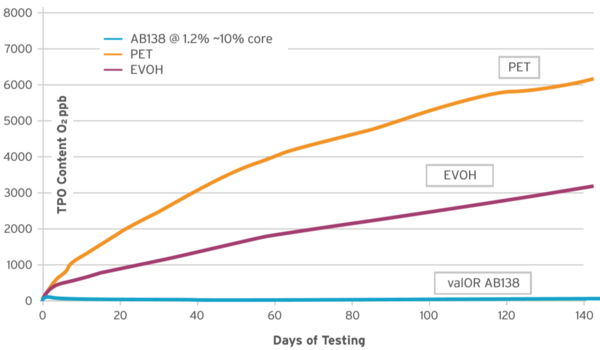

VALOR® Barrier and Scavenger resins enable a longer shelf life for products packaged in PET plastic
Sherwin-Williams, through its Global Packaging Coatings division, provides internal and external systems for nearly every packaging use. This division formulates technologies for light metal packaging, as well as for materials other than metal cans, including the valOR® product line of barrier and scavenger resins for PET plastic.
Packaging Permeability
As a result of the packaging industry reducing costs for PET, its packaging is more lightweight with thinner side walls because it uses less plastic. The thinner material allows more oxygen to enter and more carbon dioxide to escape a package. Shelf life of food and beverages sealed in plastic is dependent on the ability of the package to prevent O2 from entering and/or CO2 from escaping. Even a small exposure to O2 can make products unappealing or spoiled, while the loss of CO2 causes carbonated beverages to go flat.
It is crucial to protect products from O2. When oxygen reacts with packaged foods and beverages it can alter the contents to the point of detriment. O2 finds its way into foods and beverages through various interactions during processing. Oxygen can enter during the package filling process, creating an entrapped interaction, or it can infiltrate the walls of container materials that are permeable to oxygen.
Plastic has a wide range of permeability, a property meaning that even though the material appears solid, gas is able to pass through – including oxygen and carbon dioxide. The thinner side walls of PET plastic increase its packaging permeability. Solving the issues of O2 and CO2 permeability is important to maintaining product quality and achieving a reasonable shelf life for food and beverages.

Fig 1: valOR® Monolayer AB135J vs. 2% Competition in 500ml Clear Juice Bottles (Data collected from internal testing)
Barrier and Scavenger Resins
In order to preserve the original quality of packaged products with a longer shelf-life, a barrier or scavenger is added to PET plastic. Barriers prevent transmission of oxygen and carbon dioxide by adding layers of resins to the PET package wall, which can be done as a multilayer or monolayer. For a multilayer, structures of two or more layers of different materials form the package wall. In a monolayer, the barrier material is added directly into the PET.
Scavengers remove oxygen already found inside the plastic container. Instead of blocking O2, oxidizable scavengers capture oxygen chemically and isolate it from the packaged product.
The Sherwin-Williams product line valOR® is made up of a family of barrier and scavenger resins that provide improved process ability, delamination resistance and compatibility with PET. valOR is a direct solution to plastic permeability because the products control gas transmission through the package walls, which block porosities in PET polymers and capture undesired O2 molecules.

Fig 2: Barrier Improvement Factor Based on the Results in Fig. 1 (Total Permeation)
Advantages of valOR®
The valOR family of barrier and scavenger resins are an effective solution to maximizing packaged product shelf life and resisting delamination. valOR barrier and scavenger resins are easily added to plastic using standard injection and blow molding processes, which optimize the integrity of the entire package. The product line consists of three solutions: AB135J and A115J for monolayer and AB138J for multilayer, all of which provide an extremely long shelf life to plastic packaging without significant product change.
These solutions ensure packaging effectively retains carbonation and controls O2 levels. With heavy-duty scavenging, internal O2 is captured and any O2 trying to enter externally is intercepted, which is ideal for monolayer or multilayer packaging that needs dissolved or residual O2 to be removed after a package is sealed. This product line also offers a total barrier and scavenger performance in multilayer structures.
In full compliance with all FDA regulations, valOR products preserve the freshness and appearance of beverages, dressing and sauces, as well as fresh foods. valOR helps to prevent gas permeability using fewer additives, even with less PET plastic per packaging. This reduces the ingress of oxygen and carbon dioxide and extends use-by dates for products without the loss of color, taste and vitamin levels. As a result, customers can achieve material cost reductions because they do not have to throw away packaged products as quickly.

Fig 3: valOR® Multilayer vs. Competition in 500ml Ketchup/Mayo/Sauce Bottles, 0.35 - 0.5 mm wall (Data collected from internal testing)
Recycling valOR® Resins
Colored bottles, strapping and fiber materials that use valOR are recyclable at concentrations as high as six percent. valOR also has no measurable impact on the new enzyme recycling process that reverts monomers for conversion back into polymers. Through independent testing, valOR® AB135J has been shown to meet the clear bottle-to-bottle and high dilution levels using current protocols.
The comPETence center provides your organisation with a dynamic, cost effective way to promote your products and services.

magazine
Find our premium articles, interviews, reports and more
in 3 issues in 2025.


